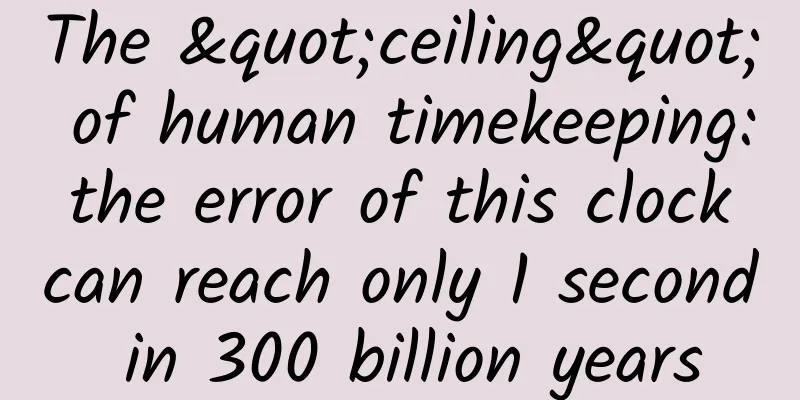The "ceiling" of human timekeeping: the error of this clock can reach only 1 second in 300 billion years

|
Produced by: Science Popularization China Author: Luan Chunyang (PhD, Department of Physics, Tsinghua University) Producer: China Science Expo Mendeleev, who discovered and summarized the periodic law of elements, once said, "Science begins with measurement." This sentence means that there would be no modern natural science without precise measurement, and the improvement of measurement accuracy often leads to the discovery of new scientific laws. Mendeleev, the scientist who discovered and summarized the periodic law of elements (Photo source: veer photo gallery) In the previous article, we mainly introduced the principles and advantages of quantum precision measurement. Different from the classical precision measurement we are familiar with, the quantum precision measurement scheme uses natural microscopic particles as the physical measurement benchmark , which means that the measurement results have extremely high parameter stability in theory. In addition, the quantum precision measurement scheme also makes full use of the quantum effects of the microscopic particles themselves, making them act as a "quantum ruler" to accurately respond to changes in the physical quantity to be measured, thereby breaking through the accuracy limit of classical precision measurement. In today's article, we will learn about a "quantum ruler" that can precisely measure time. Finding the footsteps of precise time Before officially sharing the story of the first "quantum ruler", let me ask you a question that is both familiar and unfamiliar: how can we measure time accurately? Maybe you will answer, table. But in fact, there is no unified standard answer to this question. This is because theoretically, any periodic natural phenomenon can be used as a standard for measuring time, and the watch is just one of the ways we use this principle to measure time in our daily lives. In the early stages of civilization, people roughly divided time based on the periodic phenomena of celestial motion and used them as timekeeping standards. For example, we can use the Earth's revolution and rotation periods to roughly define "a year" and "a day." Similarly, we can use the projection of sunlight on the ground at different times to create sundials, thereby roughly recording different times. Defining the concepts of "day" and "year" based on the rotation and revolution of the Earth (Photo source: veer photo gallery) We no longer use this primitive method for precise measurement, because the period of celestial motion is not uniform, and this method of measurement is also easily disturbed by natural factors such as weather. This leads to large deviations in the early time measurement results. Entering the industrial civilization stage, people found that the mechanical vibration period of some industrial products was very short and also had high stability. Therefore, scientists began to use the fixed period of mechanical vibration as a benchmark for precise measurement of time, thereby improving the accuracy of time measurement. For example, we can use a quartz oscillator with a very short mechanical vibration period to make a quartz clock with extremely accurate timing. The principle of quartz clock is that when the quartz oscillator is powered, it can continuously output a stable mechanical vibration period, which can be used to accurately measure time. Quartz clock based on quartz oscillator for precise timekeeping (Photo source: veer photo gallery) The most accurate quartz clock in the world today can measure time with an accuracy of one hundred thousandth of a second, which means that it will produce a measurement error of one second every 270 years. Such errors are caused by inevitable process defects and performance aging. For our daily life, such an error is very small and can fully meet our requirements for time measurement. However, for fields such as scientific research that require higher precision, such an error is difficult to be satisfactory. Therefore, scientists began to turn their attention to the wonderful quantum properties in the microscopic world, hoping to find a more precise and stable vibration period, thereby further improving the accuracy of time measurement. Find the answer in atoms Fortunately, scientists** have discovered extremely stable vibration cycles inside very small single atoms, which is the so-called "atomic energy level transition." ** In other words, we have gotten rid of the artificial time measurement standard and started to use single atoms as natural clocks, thus truly entering the era of quantum precision measurement. So what is atomic energy transition? In the description of classical physics, each atom is composed of a nucleus and extranuclear electrons. The extranuclear electrons are like the orbiting planets in the solar system, always moving in a circle around the central nucleus. This is the Rutherford planetary model that we are familiar with in middle school classes. You may not believe it, but this planetary model based on classical physics is actually wrong. This is because the Rutherford planetary model itself contains a profound physical contradiction. Schematic diagram of Rutherford's planetary model. The electrons outside the nucleus revolve around the nucleus in the center, and the nucleus is composed of even smaller protons and neutrons. (Photo source: veer photo gallery) Since the nucleus carries a positive charge and the electrons outside the nucleus carry a negative charge, when the electrons outside the nucleus move around the central nucleus, the rotating electrons outside the nucleus will radiate electromagnetic waves into the surrounding space. As the electrons outside the nucleus continue to radiate electromagnetic waves, the total energy of the atomic system itself is gradually decreasing. As a result, the radius of the electrons outside the nucleus moving around the nucleus will become smaller and smaller, and will continue to approach the central nucleus along the spiral motion trajectory. Until finally, the electrons outside the nucleus will collide with the positively charged nucleus, resulting in charge annihilation, and ultimately leading to the collapse of the atomic structure. In this case, it should be impossible for a single atom to exist. In order to solve the problems encountered by the atomic model in classical physics, physicist Niels Bohr proposed an atomic model that follows the quantization hypothesis in quantum mechanics. In the new atomic model, the electrons outside the nucleus no longer move along the orbits in the classical sense, but can only be specifically distributed in discontinuous energy states outside the nucleus, and this discrete energy state is called "energy level structure." That is to say, the electrons outside the nucleus no longer move in a circle around the nucleus, but are distributed in various orbits with a certain probability. In particular, when atoms are driven by external lasers or microwave fields, the electrons outside the nucleus can transition between specific discrete energy levels, and the period of this transition is extremely short, generally only 0.01 nanoseconds (1 nanosecond = 10∧-9 seconds) to complete. Therefore, this electron transition characteristic based on the quantized atomic model is also called " atomic energy level transition ." Since the transition between atomic energy levels can only be achieved through the application of laser fields, microwave fields, etc., there is no so-called collapse of the atomic structure. Therefore, the atomic model based on the quantization hypothesis perfectly solves the contradictions in the Rutherford planetary model. Electrons outside the nucleus can jump between different atoms (for example, when an electron outside the nucleus jumps from the energy state of n=3 to the energy state of n=2, it does not need to go through a path between the two energy states, but only takes 0.01 nanoseconds to appear directly in the energy state of n=2) (Image source: Wikipedia) As the study of atomic structure continues to deepen, scientists have experimentally accurately measured the energy level structure of different atoms. For example, the energy level difference between the two hyperfine energy levels in cesium-133 atoms is 9.192631770 GHz. This means that when the extranuclear electrons of cesium-133 atoms transition between these two energy levels, they can complete more than 9 billion rapid vibrations in just one second, thus having a vibration period far lower than the crystal oscillator mentioned above (about 100,000 times per second). Since the energy level structure of atoms is determined by the physical properties of the atoms themselves, it has extremely high natural stability. At the same time, the energy level structure of the same type of atoms is also naturally consistent. This means that this solution that uses the quantum characteristics of atomic energy level transitions for precise timing is not easily disturbed by the external environment during use, nor will it have process defects due to different manufacturing batches. Because of this, scientists use the wonderful property of atomic energy level transitions as a "quantum ruler" to build a single atom into an extremely precise clock. It also has a more vivid name - the atomic clock . The most accurate clock in the world It is precisely because of its extremely high natural stability and time measurement accuracy that this atomic clock built based on the characteristics of atomic energy level transitions has attracted widespread attention from academia and industry as soon as it came out. Taking cesium-133 atoms as an example, scientists have successfully developed a cesium atomic clock with extremely high accuracy. Research results show that the time measurement accuracy of the cesium atomic clock can reach the range of 0.00000000001 seconds (don’t count, there are 10 zeros after the decimal point), which means that the cesium atomic clock has a timing error of only about 1 second every 100 million years of operation , thus breaking through the upper limit of the accuracy of the classical time measurement scheme. Schematic diagram of the structure of cesium-133 atom (Photo source: veer photo gallery) In fact, as early as 1967, the 13th International Conference on Weights and Measures used the cesium atomic clock as a new timekeeping standard and redefined the concept of a second. That is, the duration of 9,192,631,770 periodic oscillations between the two hyperfine energy levels of the ground state of the cesium-133 atom. In order to further improve the accuracy of time measurement, scientists have successfully developed new atomic clocks based on strontium atoms, ytterbium atoms, etc. Among them, the extranuclear electrons in strontium-87 atoms can complete nearly 100 trillion rapid vibrations in just one second, that is to say, the time measurement accuracy of the "strontium atomic clock" can reach 0.00000000000000001 seconds (don't count, there are 15 zeros after the decimal point). Verifying general relativity at the millimeter scale using strontium atomic clocks (Image source: Reference [1]) In 2022, Ye Jun's team from the JILA laboratory at the University of Colorado, USA, created the world's most accurate "strontium atomic clock", which can measure time with an accuracy of only 1 second in 300 billion years. The relevant research results were published in the journal Nature. This means that on the time scale of the entire age of the universe (about 13.8 billion years), the most accurate atomic clock has an error of less than 0.05 seconds. Conclusion It is not difficult to find that the quantum precision measurement of time is not that mysterious. It is based on the wonderful characteristic of atomic energy level transition in quantum mechanics to transform the atoms we are familiar with into a new "quantum ruler", making it a new time measurement benchmark. In addition to atomic clocks, scientists have already used quantum precision measurement to achieve high-sensitivity measurements of key physical quantities such as gravitational fields and magnetic fields, which are widely used in our current actual production and life. So, what quantum properties is the second "quantum ruler" based on? What more magical powers does it have? References [1] Bothwell T, Kennedy CJ, Aeppli A, et al. Resolving the gravitational redshift across a millimetre-scale atomic sample[J]. Nature, 2022, 602(7897): 420-424. |
<<: There are so many stars in the universe, why is the sky dark at night?
>>: How can you pay by just tapping?
Recommend
Competitive product analysis: 5 scenarios of competitive product analysis methods
Competitive product analysis occupies a very magi...
Is it a rumor that spinach is high in iron?
We have heard countless rumors and lies since we ...
4 key points to quickly optimize the bidding OCPC delivery effect
In recent years, the competition for traffic in b...
How do you start to create an offline event?
1. To organize a successful offline event , we ne...
The fission gameplay of Weibo traffic diversion!
I have been in the Internet circle for 6 years an...
International Asteroid Day | Alien “Guests”: Are Asteroids Guarding the Secrets of the Solar System’s “Childhood”?
Today is International Asteroid Day. According to...
Is laser surgery for myopia, which uses laser to "carve" the cornea quickly and accurately, safe?
...
[Creative Incubation Program] Is the plot of "Jurassic World" realistic? Can we resurrect dinosaurs?
Author: Liu Sen Recently, Jurassic World 3 was re...
How much does it cost to create a course mini app in Hangzhou?
The factors affecting the quotation of Hangzhou c...
Bao Juncheng: ATA All-round Literacy - Reading Chinese Stories (A)
A unique learning dimension: explaining Chinese s...
What should I do if I spend money on Baidu promotion but there is no effect?
I believe that many business owners or managers w...
iOS 16.4 will add new features that have been withdrawn
In the iOS 16.2 update, Apple intended to release...
7 Common Marketing Methods Marketers Must Know (I)
Every year there are many good marketing cases . ...
Where might carcinogens be hidden in our lives?
Dangerous carcinogens are hidden everywhere in ou...
It is green, but why is it so hard to see trees on the grassland?
Author: Duan Yuechu and Huang Yanhong When we ste...









